
Fingerprints & Behavior: Advanced Explorations involving Personality & Temperament!

- Publication date: january 13, 2016 -
Fingerprints & Behavior:
Advanced Explorations involving Personality & Temperament!
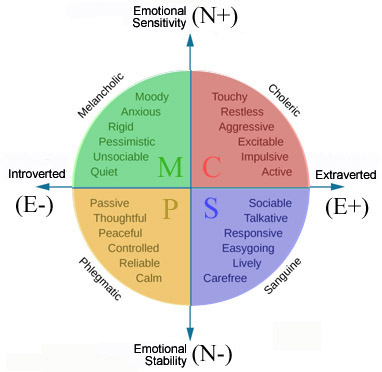 Frequency distributions for fingerprint patterns on all ten fingers summarized indicate that fingerprint patterns appear to correlate with the Big Five personality dimensions Neuroticism & Extraversion, plus the 4 classic temperaments (see picture + table in the next section below). However, the presence of any specific pattern provides also appears to provide at best only a (weak) clue for specific behaviors. This insight underlines the need to consider other factors as well, such as e.g. pattern size & distribution of patterns on individual fingers.
Frequency distributions for fingerprint patterns on all ten fingers summarized indicate that fingerprint patterns appear to correlate with the Big Five personality dimensions Neuroticism & Extraversion, plus the 4 classic temperaments (see picture + table in the next section below). However, the presence of any specific pattern provides also appears to provide at best only a (weak) clue for specific behaviors. This insight underlines the need to consider other factors as well, such as e.g. pattern size & distribution of patterns on individual fingers.
NOTICE: The four quadrants used in Hans Eysenk's personality theory describe how two important factors account for fundamental variations in our personalities; these quadrants are sometimes compared with the four temperaments described by the Greeks: choleric, melancholic, phlegmatic, and sanguine temperament (see picture displayed on the right). A similar tendency is seen in the fingerprint results presented in the picture below!
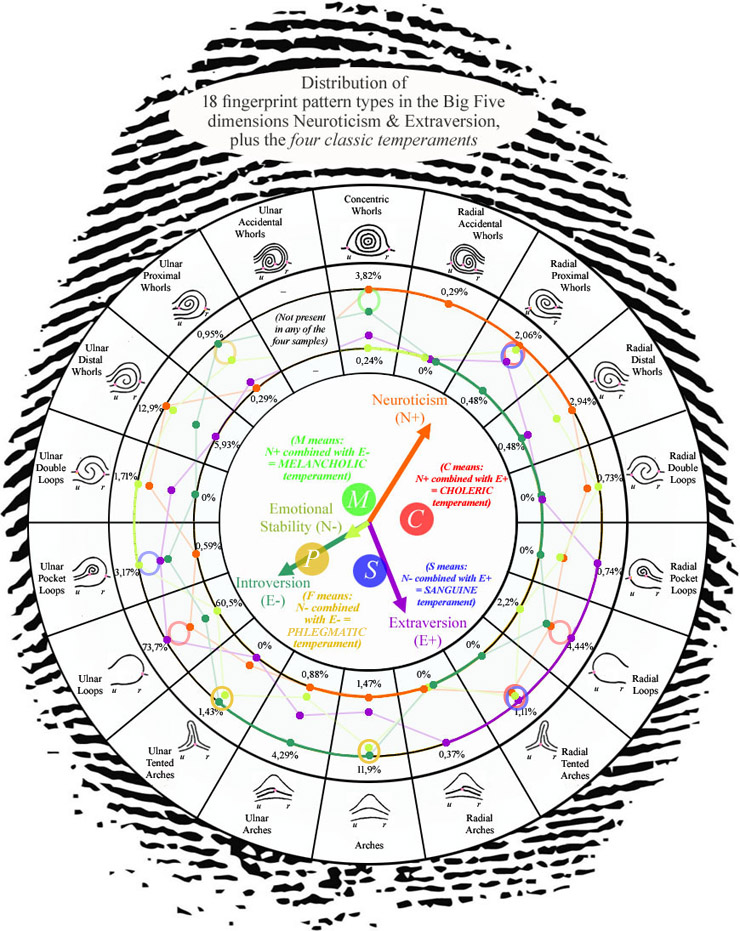
personality dimensions Neuroticism & Extraversion, plus derived tendencies for the four classic
temperaments: Choleric, Melancholic, Phlegmatic & Sanguine; displayed percentages represent
the lowest- and highest value observed among the 4 personality groups (N+, N-, E+ & E-).
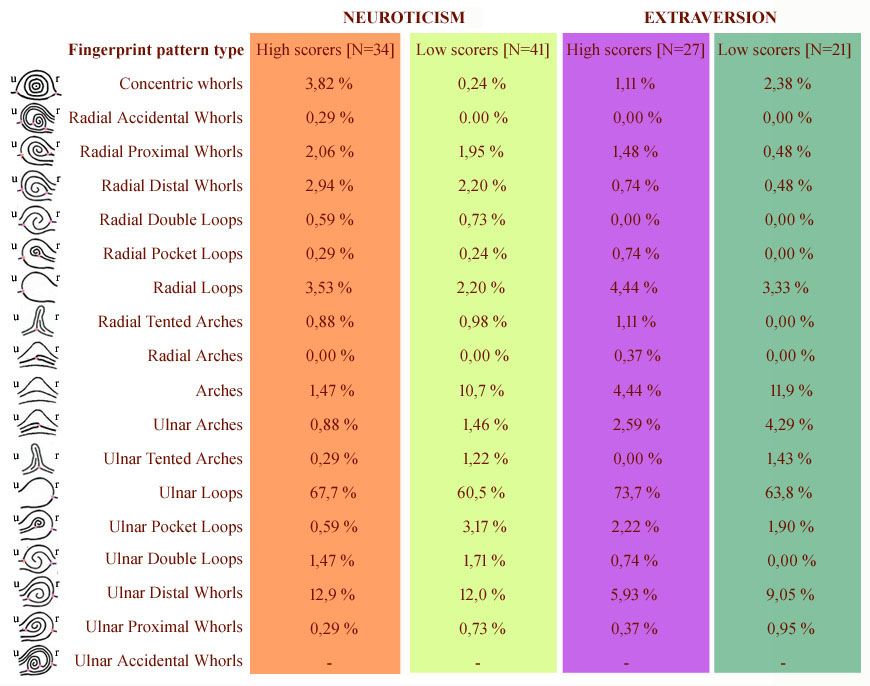
the Big Five personality dimensions Neuroticism & Extraversion: percentages.
Behavior tendencies observed for the distribution of
individual fingerprint pattern types for all ten fingers summarized!
![Concentric Whorl [CW] fingerprint pattern type.](http://www.handresearch.com/fingerprints/pics/concentric-whorl-fingerprint-pattern-type.jpg) Concentric Whorl [CW]: Neuroticism high scorers (N+) show by far the highest prevalence of concentric whorls; this concerns even a small majority of all CW-s seen inside the four personality groups together.
Additionally, in the perspective of the temperaments the results indicate that CW-s might produce a high correlation for the Melancholic temperament (= N+ combined with E-).
Concentric Whorl [CW]: Neuroticism high scorers (N+) show by far the highest prevalence of concentric whorls; this concerns even a small majority of all CW-s seen inside the four personality groups together.
Additionally, in the perspective of the temperaments the results indicate that CW-s might produce a high correlation for the Melancholic temperament (= N+ combined with E-).
![Radial Accidental Whorl [RAW] fingerprint pattern type.](http://www.handresearch.com/fingerprints/pics/radial-accidental-whorl-fingerprint-pattern-type.jpg) Radial Accidental Whorl [RAW]: this pattern has been notified only once in 1 Neuroticism high scorer (N+); RAW-s are not present in any of the other 3 personality groups.
Radial Accidental Whorl [RAW]: this pattern has been notified only once in 1 Neuroticism high scorer (N+); RAW-s are not present in any of the other 3 personality groups.
![Radial Proximal Whorl [RPW] fingerprint pattern type.](http://www.handresearch.com/fingerprints/pics/radial-proximal-whorl-fingerprint-pattern-type.jpg) Radial Proximal Whorl [RPW]: the distribution is relatively even among the 4 personality groups; most apparent is the tendency towards low prevalence of RPW-s in Extraversion low scorers (E-).
Additionally, regarding the temperaments RPW-s show a small tendency towards the Choleric temperament (= N+ combined with E+), and the Sanguine temperament (= N- combined with E+).
Radial Proximal Whorl [RPW]: the distribution is relatively even among the 4 personality groups; most apparent is the tendency towards low prevalence of RPW-s in Extraversion low scorers (E-).
Additionally, regarding the temperaments RPW-s show a small tendency towards the Choleric temperament (= N+ combined with E+), and the Sanguine temperament (= N- combined with E+).
![Radial Distal Whorl [RDW] fingerprint pattern type.](http://www.handresearch.com/fingerprints/pics/radial-distal-whorl-fingerprint-pattern-type.jpg) Radial Distal Whorl [RDW]: the variations among the 4 personality groups do not show any clear tendency for this pattern.
Radial Distal Whorl [RDW]: the variations among the 4 personality groups do not show any clear tendency for this pattern.
![Radial Double Loop [RDL] fingerprint pattern type.](http://www.handresearch.com/fingerprints/pics/radial-double-loop-fingerprint-pattern-type.jpg) Radial Double Loop [RDL]: the variations among the 4 personality groups do not show any clear tendency for this pattern.
Radial Double Loop [RDL]: the variations among the 4 personality groups do not show any clear tendency for this pattern.
 Radial Pocket Loop [RPL]: Neuroticism low scorers (N-) show by far the highest prevalence of RPL-s; the RPL-s inside this group even represent a small majority of all RPL-s seen inside the four personality groups together.
Radial Pocket Loop [RPL]: Neuroticism low scorers (N-) show by far the highest prevalence of RPL-s; the RPL-s inside this group even represent a small majority of all RPL-s seen inside the four personality groups together.
![Radial Loop [RL] fingerprint pattern type.](http://www.handresearch.com/fingerprints/pics/radial-loop-fingerprint-pattern-type.jpg) Radial Loop [RL]: the distribution of this pattern is relatively even among the 4 personality groups.
Additionally, in the perspective of the temperaments the strongest tendency appears to be that radial loops might produce a high correlation for the Choleric temperament (= N+ combined with E+).
Radial Loop [RL]: the distribution of this pattern is relatively even among the 4 personality groups.
Additionally, in the perspective of the temperaments the strongest tendency appears to be that radial loops might produce a high correlation for the Choleric temperament (= N+ combined with E+).
![Radial Tented Arch [RTA] fingerprint pattern type.](http://www.handresearch.com/fingerprints/pics/radial-tented-arch-fingerprint-pattern-type.jpg) Radial Tented Arch [RTA]: despite the fact that this pattern has not been notified among Extraversion low scorers (E-), the distribution of this pattern does appear to be relatively even among the other personality groups.
Additionally, in the perspective of the temperaments the strongest tendency appears to that RTA-s might produce a significantly high correlation for the Sanguine temperament (= N- combined with E+), and possibly the Choleric temperament (= N+ combined with E+).
Radial Tented Arch [RTA]: despite the fact that this pattern has not been notified among Extraversion low scorers (E-), the distribution of this pattern does appear to be relatively even among the other personality groups.
Additionally, in the perspective of the temperaments the strongest tendency appears to that RTA-s might produce a significantly high correlation for the Sanguine temperament (= N- combined with E+), and possibly the Choleric temperament (= N+ combined with E+).
![Radial Arch [RA] fingerprint pattern type.](http://www.handresearch.com/fingerprints/pics/radial-arch-fingerprint-pattern-type.jpg) Radial Arch [RA]: this pattern has been notified only once in 1 Extraversion high scorer (E+); RA-s are not present in any of the other 3 personality groups.
Radial Arch [RA]: this pattern has been notified only once in 1 Extraversion high scorer (E+); RA-s are not present in any of the other 3 personality groups.
![Arch [A] fingerprint pattern type.](http://www.handresearch.com/fingerprints/pics/arch-fingerprint-pattern-type.jpg) Arch [A]: high prevalence for this pattern has been notified especially in Extraversion low scorers (E-), and in Neuroticism low scorers (N-) as well.
Additionally, in the perspective of the temperaments the results indicate that arches are likely associated with a high tendency towards the Phlegmatic temperament (= N- combined with E-).
Arch [A]: high prevalence for this pattern has been notified especially in Extraversion low scorers (E-), and in Neuroticism low scorers (N-) as well.
Additionally, in the perspective of the temperaments the results indicate that arches are likely associated with a high tendency towards the Phlegmatic temperament (= N- combined with E-).
![Ulnar Arch [UA] fingerprint pattern type.](http://www.handresearch.com/fingerprints/pics/ulnar-arch-fingerprint-pattern-type.jpg) Ulnar Arch [UA]: Extraversion low scorers (E-) show by far the highest prevalence of UA-s - both in relative- and absolute values - despite the fact that this group actually concerns the smallest among the 4 personality groups.
Ulnar Arch [UA]: Extraversion low scorers (E-) show by far the highest prevalence of UA-s - both in relative- and absolute values - despite the fact that this group actually concerns the smallest among the 4 personality groups.
![Ulnar Tented Arch [UTA] fingerprint pattern type.](http://www.handresearch.com/fingerprints/pics/ulnar-tented-arch-fingerprint-pattern-type.jpg) Ulnar Tented Arch [UTA]: high prevalence for this pattern has been notified especially in Extraversion low scorers (E-), and in Neuroticism low scorers (N-) as well.
Additionally, in the perspective of the temperaments the results indicate that UTA-s are likely associated with a high tendency towards the Phlegmatic temperament (= N- combined with E-).
Ulnar Tented Arch [UTA]: high prevalence for this pattern has been notified especially in Extraversion low scorers (E-), and in Neuroticism low scorers (N-) as well.
Additionally, in the perspective of the temperaments the results indicate that UTA-s are likely associated with a high tendency towards the Phlegmatic temperament (= N- combined with E-).
![Ulnar Loop [UL] fingerprint pattern type.](http://www.handresearch.com/fingerprints/pics/ulnar-loop-fingerprint-pattern-type.jpg) Ulnar Loop [UL]: the distributions of ulnar loops among the 4 personality groups can be recognized to show normal values; nevertheless, Extraversion high scorers (E+) show by far the highest prevalence.
Additionally, in the perspective of the temperaments UL-s show a small tendency towards the Choleric temperament (= N+ combined with E+).
Ulnar Loop [UL]: the distributions of ulnar loops among the 4 personality groups can be recognized to show normal values; nevertheless, Extraversion high scorers (E+) show by far the highest prevalence.
Additionally, in the perspective of the temperaments UL-s show a small tendency towards the Choleric temperament (= N+ combined with E+).
 Ulnar Pocket Loop [UPL]: Neuroticism low scorers (N-) show by far the highest prevalence of UPL-s.
Additionally, in the perspective of the temperaments UPL-s show a small tendency towards the Sanguine temperament (= N- combined with E+).
Ulnar Pocket Loop [UPL]: Neuroticism low scorers (N-) show by far the highest prevalence of UPL-s.
Additionally, in the perspective of the temperaments UPL-s show a small tendency towards the Sanguine temperament (= N- combined with E+).
![Ulnar Double Loop [RDL] fingerprint pattern type.](http://www.handresearch.com/fingerprints/pics/ulnar-double-loop-fingerprint-pattern-type.jpg) Ulnar Double Loops [UDL]: Neuroticism low scorers (N-) show by far the highest prevalence of UDL-s; the UDL-s observed in this personality group represent half of the UDL-s observed among all 4 personality groups together.
Ulnar Double Loops [UDL]: Neuroticism low scorers (N-) show by far the highest prevalence of UDL-s; the UDL-s observed in this personality group represent half of the UDL-s observed among all 4 personality groups together.
![Ulnar Distal Whorl [UDW] fingerprint pattern type.](http://www.handresearch.com/fingerprints/pics/ulnar-distal-whorl-fingerprint-pattern-type.jpg) Ulnar Distal Whorl [UDW]: the distribution of this pattern is relatively flat among the 4 personality groups; nevertheless, by far the lowest prevalence is present among the Extraversion high scorers (E+).
Ulnar Distal Whorl [UDW]: the distribution of this pattern is relatively flat among the 4 personality groups; nevertheless, by far the lowest prevalence is present among the Extraversion high scorers (E+).
![Ulnar Proximal Whorl [UPW] fingerprint pattern type.](http://www.handresearch.com/fingerprints/pics/ulnar-proximal-whorl-fingerprint-pattern-type.jpg) Ulnar Proximal Whorl [UPW]: high prevalence for this pattern has been notified in especially Extraversion low scorers (E-).
Additionally, in the perspective of the temperaments UPW-s appear to show a small tendency towards the Phlegmatic temperament (= N- combined with E-).
Ulnar Proximal Whorl [UPW]: high prevalence for this pattern has been notified in especially Extraversion low scorers (E-).
Additionally, in the perspective of the temperaments UPW-s appear to show a small tendency towards the Phlegmatic temperament (= N- combined with E-).
![Ulnar Accidental Whorl [UAW] fingerprint pattern type.](http://www.handresearch.com/fingerprints/pics/ulnar-accidental-whorl-fingerprint-pattern-type.jpg) Ulnar Accidental Whorl [RAW]: this concerns the only among the 18 fingerprint pattern types that has not been notified in any of the 4 personality groups.
Ulnar Accidental Whorl [RAW]: this concerns the only among the 18 fingerprint pattern types that has not been notified in any of the 4 personality groups.
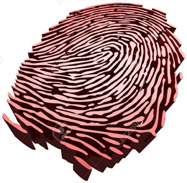
Distribution of fingerprint patterns in individuals fingers
for each of the four Big Five personality groups (N+, N-, E+ & E-)
Some of the most significant tendencies are summarized for each personality group below; none of these tendencies are present inside the counter-group. Next to the fingerprint pattern type, in these descriptions is sometimes also refered to pattern size: a 'large' pattern refers to a fingerprint where the outer triradius is not visible in the prints, and an 'extra large' pattern refers to whorls where both triradii are not visible in the print.
• Neuroticism high scorers [N+]:
The first three of the following combinations are found in 19 out of 34 Neuroticism high scorers (= 55,9%):
- Combi 1N+: various distributions involving Concentric Whorls [CW-s] appear most significant for N+: e.g. a CW on a finger other than the index finger is commonly present: 23,5% (N+: 8 out of 34, N-: 0 out of 41); multiple CW-s are also relatively common: 8.8% (N+: 3 out of 34, N-: 0 out of 41); large CW-s are also relatively common: 8.8% (N+: 3 out of 34, N-: 0 out of 41).
- Combi 2N+: Ulnar Loops (UL) on all five fingers in one hand, featured with at least one large UL: 17,6% (N+: 6 out of 34, N-: 0 out of 41).
- Combi 3N+: extra large (whorl) patterns in other fingers than the ring finger are quite common: 11,8% (N+: 4 out of 34, N-: 0 out of 41).
- Combi 4N+: presence of a combination of radial patterns in one hand, involving two different patterns on at least one other finger than the index finger: 11,8% (N+: 4 out of 34, N-: 0 out of 41); also, the rather extraordinary combination of a radial pattern on both the ring finger and pinky is present twice: 5,9% (N+: 2 out of 34, N-: 0 out of 41).
- Combi 5N+: presence of a Ulnar Distal Whorl on both the pinky and ring finger combined with an Ulnar Loop on the other 3 fingers appears typical because the presence of this combination is also featured in the other hand with a concentric whorl or radial pattern on the ring finger and/or pinky: 8,8% (N+: 3 out of 34, N-: 0 out of 41).
- Combi 6N+: presence of a large radial pattern not found on an index finger: 8,8% (N+: 3 out of 34, N-: 0 out of 41).
- Combi 7N+: pinky finger has a radial pattern or large concentric whorl: 8,8% (N+: 3 out of 34, N-: 0 out of 41).
NOTICE: One subject has a Radial Accidental Whorl on the left index finger (involving the combination of a radial loop & radial tented arch), which also appears typically unusual; this subject also has a large CW on the right ring finger. Also, there is one subject that has a radial double loop on the left middle finger (combined with a CW on the right middle finger) - which appears also slightly unusual as it provides another clue indicative for a tendency where radial patterns shift away from the index finger (combi 4N+ shows a similar tendency). And finally, there is also one subject who has 4 double loops of which 2 concern large double loops, and there is another subject who has two large double loops - which appears typically unusual as this represents another clue which indicates that N+ subjects often tend to have combinations involving large patterns featured with high complexity!
• Neuroticism low scorers [N-]:
The first two of the following combinations are found in 15 out of 41 Neuroticism low scorers (= 36,6%):
- Combi 1N-: combination of Arch patterns (A) on both the index finger & middle finger: 19,5% (N-: 8 out of 41, N-: 0 out of 34).
- Combi 2N-: combination of Ulnar Pocket Loops (UPL) patterns on two fingers, and/or one on the middle finger, and/or one in the right hand: 17,1% (N-: 7 out of 41, N-: 0 out of 34).
- Combi 3N-: pinky finger has a Arch (A) or Ulnar Arch (UA): 7,3% (N-: 3 out of 41, N+: 0 out of 34).
• Extraversion high scorers [E+]:
The combination 1E+, 2E+ and 4E+ are found in 17 out of 27 Extraversion high scorers (= 63,0.%):
- Combi 1E+: small a-typical radial patterns on the index finger {excluding: normal radial loops (RL) & any large radial patterns}: 29,6% (E+: 8 out of 27, E-: 0 out of 21).
- Combi 2E+: symmetrical distribution of pattern types in all five fingers (of both hands) featured with small patterns only: 25,9% (E+: 7 out of 27, E-: 0 out of 21).
- Combi 3E+: non-ulnar arch-related patterns (A, RA or RTA) on index finger or thumb combined with a ring finger ulnar pattern featured with two triradii [USW or UPL]: 18,5% (E+: 5 out of 27, E-: 0 out of 21).
- Combi 4E+: Radial Loop (RL) on left index finger combined with small Ulnar Loops (UL) on all other fingers of the left hand: 14,8% (E+: 4 out of 27, E-: 0 out of 21).
- Combi 5E+: radial arch-related patterns (RA or RTA) on index finger: 14,8% (E+: 4 out of 27, E-: 0 out of 21).
NOTICE: Two subjects have a Radial Pocket Loop (RPL) on one index finger, combined with a radial pattern on the other index finger + small Ulnar Loops (UL) on both thumbs & middle fingers, plus ulnar patterns on the ring- and pinky fingers (combi 5E+ shows a similar tendency).
• Extraversion low scorers [E-]:
The combination 1E-, 3E- & 4E- are found in 12 out of 21 Extraversion high scorers (= 57,1.%):
- Combi 1E-: small non-radial arch-related patterns on index finger & middle finger in at least one hand (A, UA) combined with similar arch-related patterns or small Ulnar Loops (UL) on all other fingers: 28,6% (E-: 6 out of 21, E+: 0 out of 27).
- Combi 2E-: non-radial pinky finger arch-related patterns (A, UA or UTA): 19,0% (E-: 4 out of 21, E+: 0 out of 27).
- Combi 3E-: involves a rather complex combination involving [1] L-R pattern asymmetry on at least two fingers, combined with a typical distribution of pattern on the five fingers featured with [2] a large pattern on the pinky finger, combined with [3] at least two whorl patterns including a whorl pattern on the ring finger, combined with [4] at least two ulnar loops on the three radial fingers: 23,8% (E-: 5 out of 21, E+: 0 out of 27).
- Combi 4E-: small non-radial thumb arch-related patterns (A or UA) combined with an A on at least two other fingers: 14,3% (E-: 3 out of 21, E+: 0 out of 27).
- Combi 5E-: presence of Ulnar Tented Arches (UTA): 14,3% (E-: 3 out of 21, E+: 0 out of 27).
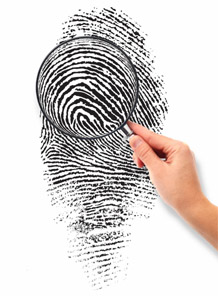
CONCLUSIONS
The reported results suggest that close to 40% of the subjects in each of the four personality groups have fingerprint pattern distributions that are not seen in the opposite group.
Neuroticism high scorers (= emotional sensitivity) typically tend to have large, complex fingerprint pattern types with a tendency towards: Concentric Whorls (CW) and/or variation of radial patterns especially involving other fingers than the index finger; Ulnar Loops (UL) in all five fingers of one hand of which at least one large pattern is also a typical combination. On the contrary, Neuroticism low scorers (= emotional stability) typically show a tendency towards having two Arch (A) patterns in one hand involving both the index- and middle finger, or a tendency for having multiple Ulnar Pocket Loops (UPL) or just one in the right hand and/or the left middle finger.
Extraversion high scorers (= extraverted) typically tend to have a symmetrical distribution of pattern types among both hands with small patterns only; also common are small patterns with a tendency towards a-typical radial patterns on the index finger, or an arch related pattern on only the thumb(s) or index finger(s) combined with an ulnar pattern featured with two triradii on the ring finger(s); Radial Loop (RL) patterns on the left index finger combined with Ulnar Loops (UL) on all other fingers of the same hand are also relatively common. On the contrary, Extraversion low scorers (= introverted) typically show a tendency towards small non-radial arch patterns combined with small Ulnar Loops on all other fingers, or a complex pattern of distribution with e.g. a large pattern on the pinky finger + a large whorl or normal sized concentric whorl on the ring finger + at least two ulnar loops on the other three fingers.
Finally, it is important to put the materials presented above involving the dermatoglyphics of the fingertips in the perspective of Multi-Perspective Hand Reading, which describes the fundamental major principle where scientific hand reading begins:
with the presence of other hand signs that also bare significance for that same theme."
Recommendations for further reading:
• What can fingerprints reveal beyond your identity?
• What are the most common fingerprint distributions on the 5 fingers?
• Explore the fingerprint world map!
• 12 Hands Signs in Neuroticism (N+) vs. Emotional Stability (N-)
• 7 Hands Signs in Extraversion (E+) vs. Introversion (E-)

the perspective of palmistry, and 'central whorls' or 'median whorls' in the perspective involving ridge counts;
but 'concentric whorls' should not be taken to represent 'meet whorls' (accordingly the Henry system).